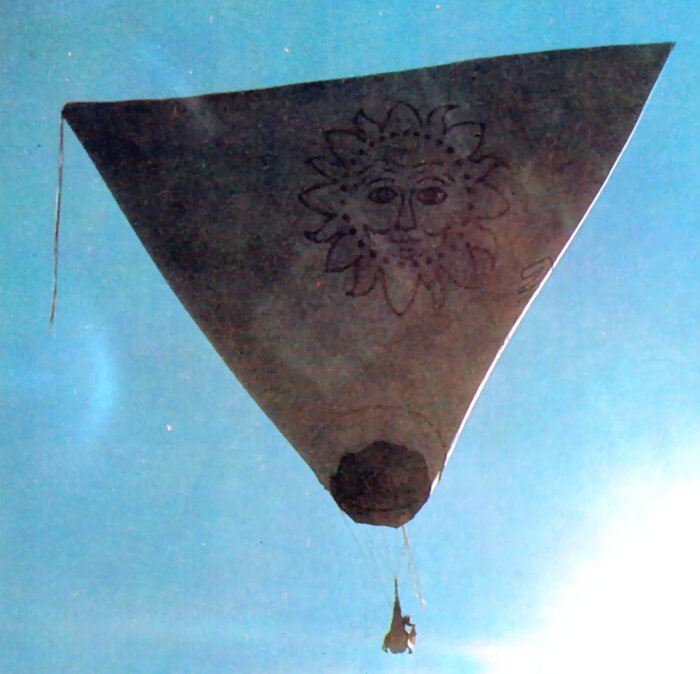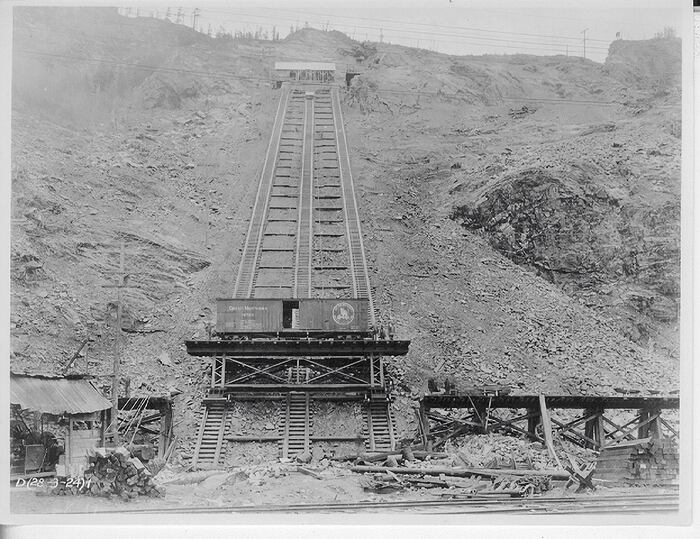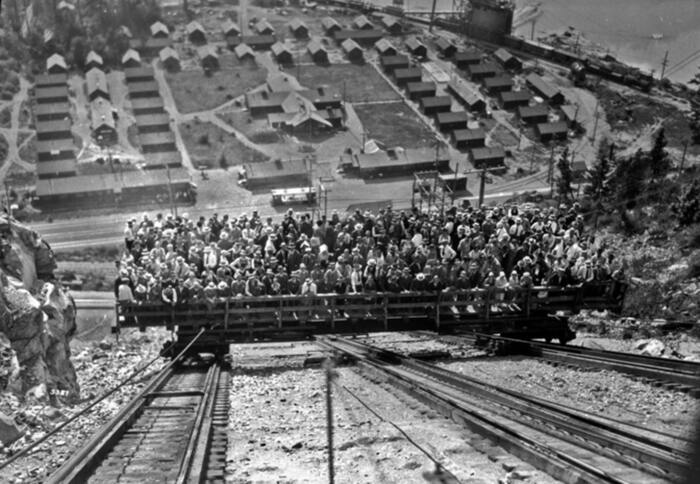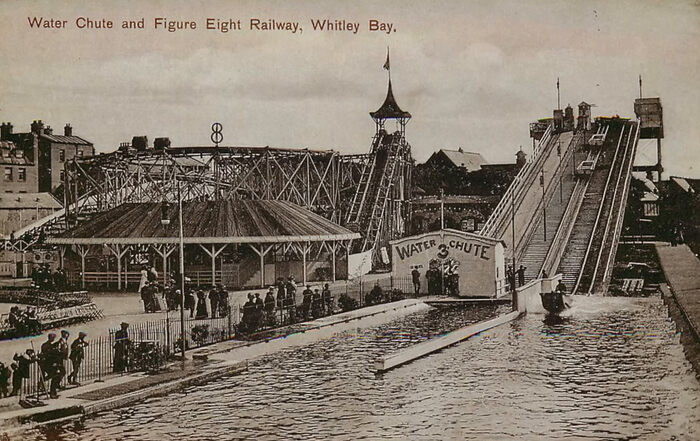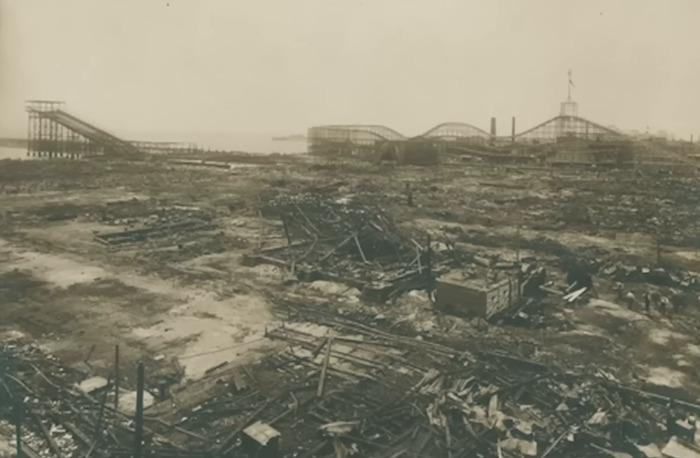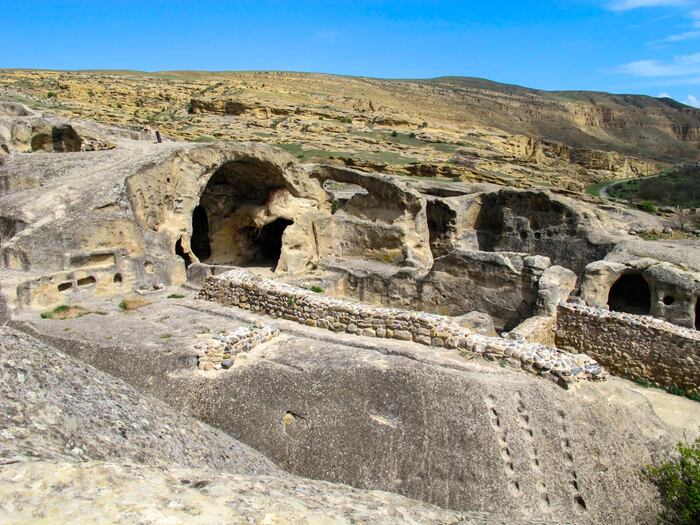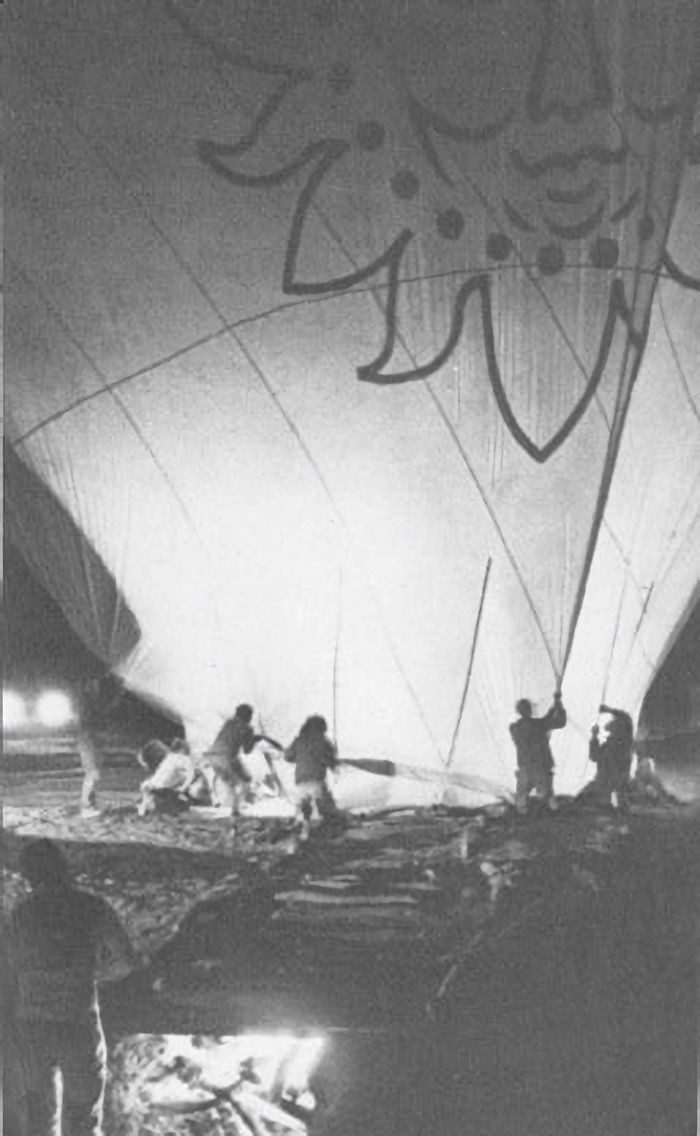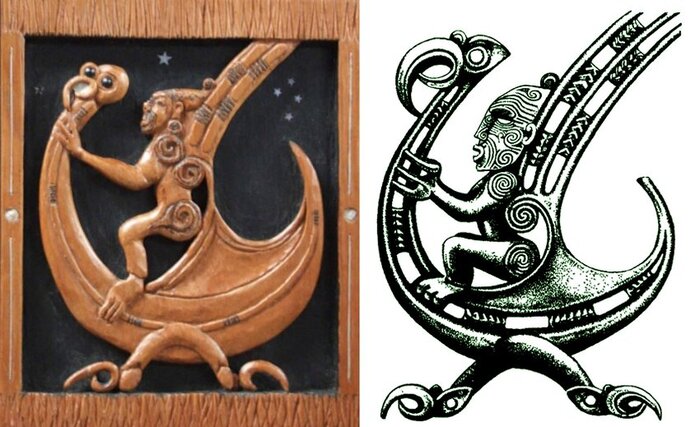Early flight is a load of hot air. Mon 24 March 2025
300ft ascent under Inca/Warin fabric. Source: The Extraordinary Nazca Prehistoric Balloon
In 1974, Julian Nott and Jim Woodman allegedly proved hot-air balloons could be made using Inca/Warin materials science and Inca/Warin weaving techniques:
Apparently with locally available body parts. Source: Experimental archaeology : Nazca secret of flight.
From The Extraordinary Nazca Prehistoric Balloon:
we successfully flew in a balloon that could have been built by the Nazca people a thousand years ago.
And so could the ancient Egyptians, the Romans, the Vikings, any civilization. With just a loom and fire you can fly!
“When we first made the flight it was amazing that we could actually leave the ground with thousand year old technology.”
Nott and Woodman were trying to prove a claim sometimes made about Nazca's geoglyphs: that their construction needed help - perhaps even direction - from above.
They were trying to prove there is no need for ancient alien theory. Just Unfamiliar Flying Objects.
Their flight provided a more down to earth explanation for artefacts attributed to Nazca's 'ancient aliens'. Such as El Fuerte de Samaipata in Bolivia:
Maybe. Source: Alien Ruins Exposed In Iraq?
I bet El Cascabel really did rattle.
Check the first frame of the video. To the lower right of El Cascabel you may see what looks like a catapult launch ramp. And viewed in this way, the entire rock structure looks like a gigantic catapult launch ramp. Rather than a quarry, the structure resembles the rock-dollops pictured in Away in a Manger - Part Four.
El Fuerte de Samaipata, Bolivia
Regardless of El Cascabel's construction technique, catapault launch ramps are one way to get winged aircraft up to flying speed:
German V-1 flying bomb - final design and lauching specs
But they're not a good way to get lightweight aircraft up to flying speed:
Because they're too good. Source: Me 163 Catapult Testing
The short tracks of El Cascabel also look a little too short. Too short to have accelerated lightweight flying machines to flying speed in a few seconds.
But perhaps El Cascabel was built to assist aircraft in a different way. Lighter-than-air (LTA) aircraft like balloons and dirigibles don't need speed to take off or land. But sometimes they need help with loading and unloading.
El Cascabel looks like an inclined plane:
Skagit Incline, Diablo Dam, Washington State. Source: Highland Garden House B & B
El Cascabel has two grooves and three 'tracks' - each track cast with diamond patterns.
Those diamond-patterned tracks look useful for maintaining grip in wet weather. Just like tyre treads. They could provide better traction for wheels or rollers. El Cascabel's two grooves look like the remains of rack mechanisms to help haul carts up and down the ramp.
Rack mechanisms a bit like the Marsh rack and pinion system:
Rack and pinion prevents backsliding. Source: Rack railway - Wikipedia
Rack and pinion was widely used in quarrying. Though any re-usable or scrappable parts that rattled El Cascabel are long gone.
In the 19th century, many inclined planes were built to raise and lower heavy loads. They were built around quarries and mines and the rail tracks, canals and rivers that serviced them.
The photograph of Skagit Incline also shows a rail track running perpendicular across the base of the incline. Inclined planes linked freight with transport systems.
The great era of (lost) American funiculars presents several photographs of funiculars and inclined planes. A few are shown loaded with carriages or trucks.
Skagit Incline was re-purposed as a tourist ride to former mine site. By then it was being marketed as a 'ghost town':
Skagit Incline, Diablo Dam, Washington State. Source: The great era of (lost) American funiculars
Skagit - and I'd argue El Cascabel too - are not the only inclined planes repurposed to attract tourists:
Tourists don't know jack. Source: 19 Unsolved Ancient Mysteries Around The World Archaeologists CANNOT Explain
Understood as cleaned-up industrial architecture, the grand stairs of Egypt's Abydos temple complex lose some of their mystery. Along with the mystery of how its 100-ton granite blocks were moved into place.
And when they look as new as they do at Abydos, inclined planes also suggest how recently the complexes' 100-ton granite blocks were moved into place.
The inclined planes used to build modern England are very well hidden. A lot of their rails, ratchets and winches seem to have continued life as farm railways, fairground and seaside rides:
Whitley Bay water chute. Yorkshire, England. Source: Charlies Garden | Was the Rock Electrified?
At Luna Park, New York, the remains of the building - centre below - give a sense of the scale of Luna Park's rails, ratchets and winches:
The Shoot, Luna Park, Coney Island, New York. Source: Magical Old-World
Stripped of their metal components, their foundations were left to fade into the landscape:
A dip for dipsos. Source: The Mystery Of The Abandoned Railway Incline Named After Ann Mayers
Ann 'Nanny' Myers ran a pub next to the incline.
Another mystery solved.
The manual version - here a three-man version - is visible in the lower right of this image:
Steps at Uplistsikhe, Georgia. Melted Hills Part 2: How the Stone Flows
Uplistsikhe - Wikipedia, Google Maps
Before you put food on the table you have to carry it home. Starting with the wood to make the table:
Source: How many CU Boulder researchers does it take to carry a log? via Chaco Canyon Mystery Solved
Toe-holds help tumpliners get wood and food over the doorstep.
Did Nott and Woodman's flight solve one of South America's 'alien artefact' secrets?
Maybe. Source: Sacsayhuaman | Incan Palace | Inca Empire
They probably didn't use hot air to lift those loads to Sacsayhuaman's 12,400 ft elevation. But then hot air isn't the only lighter-than-air gas.
Whichever gas they used, they still had to get stones - and tribute - in and out of airships that were too big to touch down. I'm suggesting El Cascabel was how they did it.
Still, many mysteries remain. One is how early balloons were made. How did the Incans or Warins of Nazca processed woven fabric so that it held hot air or gas?
Historic accounts helped Nott and Woodman find out.
From Grounding the Nazca Balloon:
Woodman claimed that he was given some pottery shards that show images of balloons and kites.
Mike [DeBakey] also brought news of a fascinating letter from Jay Hasheider, a U.S. Peace Corps volunteer in El Salvador, who had just made a lengthy study of primitive ritual smoke balloons now being used by provincial Indians throughout Central and South America. The letter detailed several tribes that still launched smoke balloons at religious festivals throughout the year.
To fill their balloon, Nott and Woodman created a smoky fire at one end of a trench tunnel:
Source: The Extraordinary Nazca Prehistoric Balloon
From The Extraordinary Nazca Prehistoric Balloon:
Thick wood-smoke flows from a fire via a trench and pours into Condor I. It cures the fabric, filling its pores. “To our surprise,” says Nott, “the quality of the smoke was crucial. Modern historians assume all that mattered was the heat and laugh at the Montgolfiers for believing what they burned was important. But this balloon showed the Montgolfiers were right: the nature of the smoke is critical.”
How do you get a fire to produce quality smoke?
Burn fat-rich materials like skin and meat.
From Did the ancient Peruvians fly hot-air balloons 1500 years ago?:
These are essentially hot air balloons where the fabric weave is sealed by using a smoky fire to deposit soot on the cloth. This same method was used by the Montgolfier brothers in their early balloons where they reportedly used old boots and rotten meat to create a smoky fire before launching.
Although they weren't accused of burning human carcasses, Woodman has subsequently been accused of grave-robbing in his search for samples of Inca/Warin fabric.
From Grounding the Nazca Balloon:
With the assistance of a local grave robber, Woodman plundered through the Nazca burial grounds gathering samples of textiles. He had these textiles analyzed and found that the weave is extremely tight and the thread count very high. He marveled that modern textiles do not come close to such high quality.
Weaving was an art practiced by almost all Andean women from the peasants to the elite classes.
Fine cloth was used as a form of currency, not only as a trade good but also to pay tribute or taxes.
And with that last statement, we may have a clue to the owners of any lighter-than-air craft that were involved with the creation of Nazca's lines, its quarry scars, and its misunderstood industrial archaeology.
Providing artisanal products as tribute to the church, to elites or even to gods is the common economic bond that links Andean women with the peasant workers of Europe and Asia. So let's look at the recipients of taxes, tithes and of course sacrifices to see if accounts of them match up with what Nott and Woodman achieved at Nazca.
Starting with feudal Europe and the requirement to supply sacrifices to to the wicca/vicar and tithes to the curate and the cleric. It's well enough examined in Gas Stations of the Past that I won't go through it again here.
Moving on to Akkadia - or, as most of us think of it, Sumer - in what is now Iraq:
Smoke gets in your mouth. Source: Confirmed, The Old Gods "Ate the Smoke" of Burnt Offerings
Or at least, the mouths of their balloons and dirigibles. This process is called curing. Speculatively: as in 'curate'.
The 1974 film Zardoz portrayed Sean Connery's encounter with the cargo ships of the 'gods'. After hiding in a grain tribute loaded into - literally - the mouth of a balloon, Connery inspects its cargo. He finds more tribute and what at first sight appears to be a consignment of blow-up dolls:
One of whom Connery menaces with his pistol. Source: Zardoz
Fictional or not, that scene may explain an embarrassing scientific mystery. Not the invention of personal crumple-zones for blow up dolls but how Australasian DNA showed up the across South America without first showing up in North and Central America.
That is, why Australasian DNA doesn't show up in the lands south American natives are alleged to have crossed on their way from Australasia via Siberia then north America to the Amazon.
the migratory route used by migrants who carried the Australasian ancestry led to the absence of this signal in the populations of Central and North America.
You may be looking at an explanation for what that migratory route actually was. A global lighter-than-air slave transport capability might also explain worldwide accounts of early flight.
For example, New Zealand's Maori believed they came from a place in the sky. They also believed in a flying god called Pourangahua:
Look familiar? Source: Maori God Pourangahua And His Flying Bird Traversing The Ancient Skies - Ancient Pages
From Maori God Pourangahua And His Flying Bird Traversing The Ancient Skies:
Maori 'god' Pourangahua flew on bird called 'Manunui-a-Ruakapanga'.
Perhaps it's just a coincidence his gondola looks so like Nott and Woodman's reed balloon seat.
Perhaps it's just a coincidence the Maori word for Pourangahua's flying machine sounds similar to one of the Indian names for a flying machine: 'pushpanka'.
After all, words travel - along with 'myths' of 'gods' who inhaled meat-smoke.
Perhaps the Atra-Hasis was faked about a century ago to project further back into the past recent memories of smoke-cured balloon skin processing. But cynicism about one book - well, actually, several thousand clay tablets - does not cancel out the twin claims that:
- sacrifice often involved burning meat, and
- balloon manufacture used the smoke of burning meat to cure fabrics, skins and possibly bladders.
I say 'possibly bladders' because I don't know if bladders are as naturally airtight as they are watertight.
But we do already know the Montgolfier brothers cared about the quality of the smoke that filled their balloons. So let's look at the possibility the Montgolfiers acquired their knowledge of meat-smoke's curing properties from a collector of taxes and tithes that spanned South American and Europe: the Church.
From Did the ancient Peruvians fly hot-air balloons 1500 years ago?:
Aside from the many flying legends that come from different parts of the world including Peru, and possible depictions of flight on pottery etc., I find it interesting that a Jesuit priest Father Bartolomeu Lourenço de Gusmão who was born and educated in Santos in Brazil by Jesuits (who used Santos as a base for exploration of the South American continent) was able to demonstrate a small hot air balloon in Lisbon to King John V of Portugal in 1709 and was granted a patent on the device.
Legend has it that he flew in a full-sized version a distance of about a kilometre at an altitude of 60 feet however he subsequently had to flee to Spain as he was about to be arrested by the Tribunal of the Inquisition.
The Montgolfier brothers didn’t manage to build a man-carrying balloon until 1783 but the flight by Francois Pilatre de Rosier and Francois Laurent, Marquis d’Arandes on November 21 1783 is usually credited as the first time humankind flew.
It seems we have globe-wide folklore plus a patent claim for hot air ballooning from before the Montgolfier's 1783 Paris flight. So an obvious next step is to unearth Father Bartolomeu Lourenço de Gusmão's 1709 patent.
Clues that balloon making was an occupation before the Montgolfier's alleged first flight in 1783 also float past in language.
From Grounding the Nazca Balloon:
[Jay] Hasheider had even discovered that the ancient Quechua Indian language of the Andes contained a word for balloon maker.
Unfortunately, the ancient Quechua word floated past too quickly, for Grounding the Nazca Balloon didn't report what it was.
More:
Source: Experimental archaeology : Nazca secret of flight.
© All rights reserved. The original author/creator of each image, video, quote or text retains full ownership and rights. They are reproduced here on fair use ('fair dealing') terms.
More of this investigation:
Misunderstood Technology
